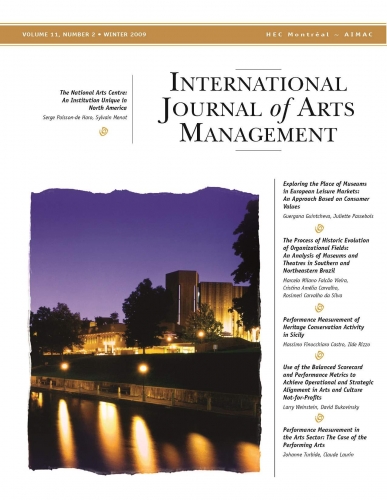The National Arts Centre: An Institution Unique in North America
Product: Article
$21.00 CA
Serge Poisson-de Haro, Sylvain Menot
Serge Poisson-de Haro is assistant professor of management at HEC Montréal. His teaching and research interests centre on the field of strategy, particularly with regard to sustainable development and issues facing arts organizations. He has served on the boards of such not-for-profit organizations as the Canadian Opera Company and DareArts for Children and has several years’ experience in management positions in the financial industry.
Sylvain Menot completed his MBA at HEC Montréal in September 2008 with a citation of Excellence. His interests centre on strategic management, particularly with regard to development of new business strategies and strategic collaboration. Following the completion of M.Sc. studies at the Swiss Federal Institute of Technology Lausanne, he held several positions as engineering project manager. At HEC Montréal he has collaborated on projects in the arts sector.
ABSTRACT
The National Arts Centre is a Canadian institution whose mandate is to foster artistic excellence in the performing arts. After a successful inaugural decade, the NAC faced a deep crisis that undermined the institution’s identity and artistic quality, reaching its nadir at the end of the 20th century. Recently appointed CEO Peter Herrndorf served as the impetus for returning the NAC to its former glory, mainly through the implementation of a five-year strategic plan around four axes: artistic expansion and innovation, emphasis on the NAC’S national role, educational activities and an increase in earned revenues. The results showed that artistic excellence had returned to the NAC’S stages but that much remained to be done. After a process of national consultation, a second strategic plan was developed to confirm the success of the first and to make adjustments in order to improve the NAC’S position and enable it to meet the expectations of all stakeholders.
KEYWORDS
Strategy, management, performing arts, strategic planning, organization
RÉSUMÉ
Le Centre national des Arts est une institution artistique canadienne dont le mandat est d’encourager l’excellence artistique dans toutes les disciplines des arts de la scène. Après une décennie faste suivant sa création, le CNA traverse une crise, minant sa qualité artistique et son identité, qui atteint son paroxysme à la fin du siècle. C’est à cette période que le nouveau PDG, Peter Herrndorf, donne l’impulsion qui s’impose pour rendre au CNA ses lettres de noblesse, notamment grâce à la mise en œuvre d’un plan stratégique sur cinq ans centré sur quatre objectifs : expansion et innovation artistiques, revalorisation du rôle du CNA à l’échelle nationale, activités éducatives et accroissement des revenus d’exploitation. À l’heure du bilan du premier plan, alors que l’excellence artistique est de nouveau présente sur les scènes du CNA, l’équipe de direction évalue les résultats obtenus. ainsi, sur la base d’une vaste consultation nationale, un second plan stratégique est élaboré pour confirmer les succès et faire les ajustements nécessaires afin que le CNA réponde à l’ensemble des attentes des parties prenantes.
MOTS CLÉS
Stratégie, gestion, arts de la scène, planification stratégique, organisation
RESUMEN
El Centro Nacional de las Artes es una institución artística canadiense cuya misión es fomentar la excelencia en todas las disciplinas de las artes escénicas. Pasada una primera década de prosperidad desde su creación, el CNA entró en un período de crisis que socavó su calidad artística y su identidad, alcanzando su punto más bajo a fines del siglo pasado. Fue entonces que su nuevo Presidente y Director General, Peter Herrndorf, imprimió a la organización el golpe de timón necesario para devolverla a su original esplendor, especialmente a través de un plan estratégico quinquenal encaminado al logro de cuatro objetivos: la expansión e innovación artísticas, la revalorización del papel del CNA como actor en la escena nacional, las actividades educativas y el aumento de los ingresos operativos. Llegado el momento de hacer el balance del primer plan, y recuperada la excelencia artística en los escenarios del CNA, el equipo directivo evaluó los resultados obtenidos. Sobre la base de un vasto proceso de consulta nacional, se elaboró un segundo plan estratégico para consolidar los logros e introducir los ajustes necesarios para que el CNA pueda satisfacer las expectativas de todas las partes interesadas.
PALABRAS CLAVE
Estrategia, gestión, artes escénicas, planificación estratégica, organización

